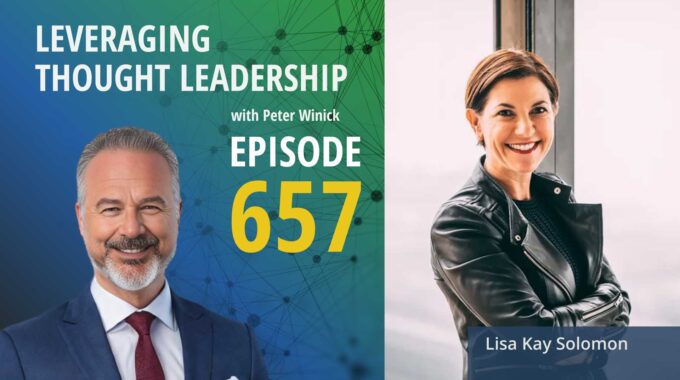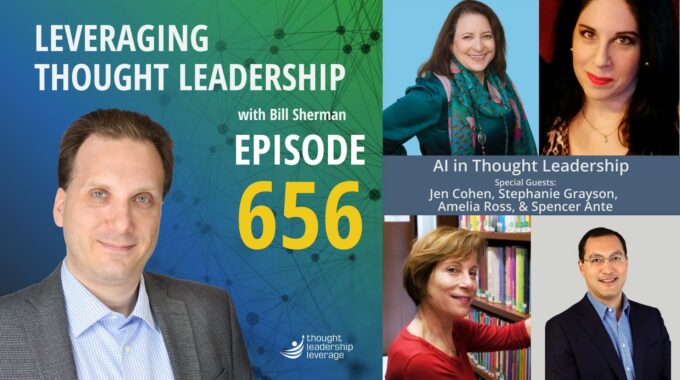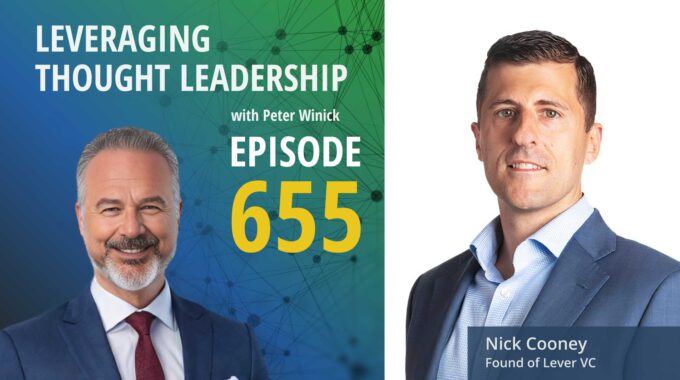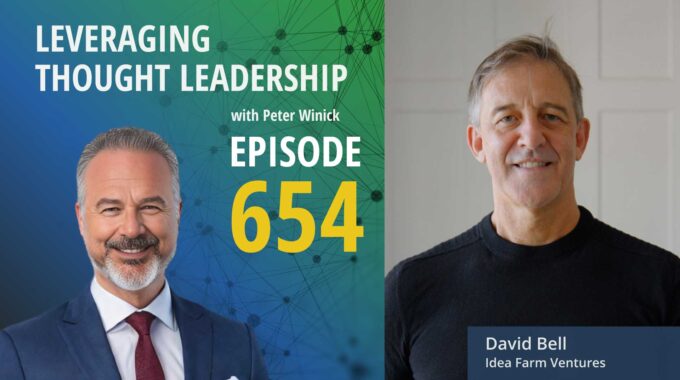How design thinking and futures literacy can transform your leadership This episode explores how leaders…
The Innovator’s Journey to Thought Leadership | Karen Hold
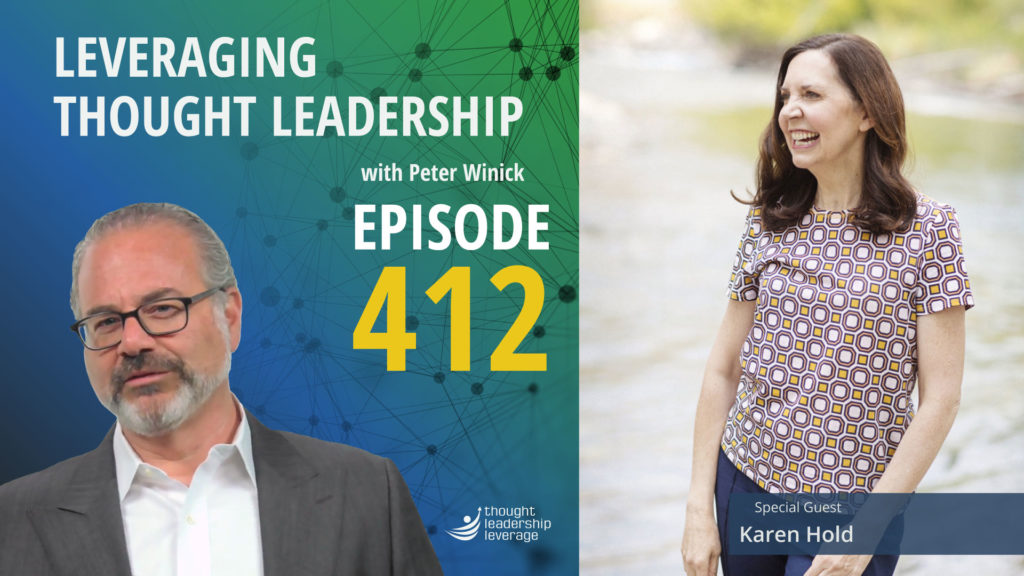
Getting your audience’s attention, and investing them in your thought leadership.
An interview with Karen Hold about her experience going from a consumer goods company to being a thought leader and author.
What does it take to become a game-changer in your industry?
We are constantly bombarded with products and brands seeking our attention and money. How can thought leadership help your brand stand out?
Today, we are joined by Karen Hold, the founder of Experience Labs and co-author of Experiencing Design: The Innovator’s Journey. Karen’s mission is to build creative capacity in individuals, organizations, and cities, using the language of design thinking. The trick is to turn abstract thought into concrete ideas, and to visualize those ideas in a way that captures your audience’s attention.
Karen takes us back to the early days of her career, at Procter & Gamble, where her focus was on the Folgers Coffee brand. At the time, as Starbucks was starting to emerge, and Folgers needed a way to stand out in order to keep its share of the market. Karen shares how Folgers studied the Starbucks experience, and – due to flawed assessment – decided that the newcomer wasn’t a threat to Folgers’ market dominance. Fast-forward to 2022, and Starbucks has a major market share – a share that could have belonged to Folgers’, if they’d determined the market need and used it to their own advantage.
Determined not to miss the next big opportunity, Karen explains how she changed her thinking. As media changed and people’s needs evolved, Karen realized that brands needed better tools to assess market needs – and step forward, staying ahead of the curve by visualizing the future and being ready for the next change. By preparing content with the right approach, you make sure that your thought leadership is there when the audience is ready to receive it.
Karen shares even more insights in her book, and discusses the amazing experience she had working with Jeanne Liedtka and Jessica Eldridge to complete and publish her thought leadership. In addition, we learn about the digital tool for creating personal development plans that was recently launched as an add-on, giving even more value to the text and its content.
Three Key Takeaways:
- Don’t blindly follow data. Use your instinct, experiment, and create thought leadership that sees around corners and tries new things.
- Ensure that your thought leadership is available in a variety of modalities. This allows you to connect with an audience, regardless of their preferred method of communication.
- Adding development tools to a thought leadership book is a method to continue the research you’ve begun, and expand your insights.
If you need a strategy to bring your thought leadership to market, Thought Leadership Leverage can assist you! Contact us for more information. In addition, we can help you implement marketing, research, and sales. Let us help you so you can devote yourself to what you do best.
Transcript
Peter Winick And welcome, welcome, welcome. This is Peter Winick. I’m the founder and CEO of Thought Leadership Leverage, and you’re joining us on the podcast today, which is Leveraging Thought Leadership. Today, my guest is Karen Hold. She’s the founder of Experience Lab. And her work is grounded in a core belief that design thinking provides an enabling social technology that’s interesting, that facilitates adoption and effective problem solving and complex solutions. Without getting into her long bio, she’s also the author of the recently published Experiencing Designs, which she is a coauthor of that came out by Columbia Business School Press not all that long ago. And I suggest you grab a copy of that if you can. So welcome, Karen. Let’s just sort of dove in.
Karen Hold Yeah, thanks. I’m happy to be here, Peter.
Peter Winick So let’s before we dove into the. Content to the thought leadership. Let’s talk about your journey because that’s always fascinating to me. So I would imagine that, you know, young Karen, as a seven year old, wasn’t dreaming and aspiring of becoming an experienced design author, among other things, or maybe more.
Karen Hold Well, now, I grew up in just outside Washington, D.C., and my dad was a lawyer. So I went to I went to Duke. Little bit further south here. Great basketball team. You study public policy because I thought I would come back to D.C. and my world in D.C. was all around politics and policy. And that’s what I did. I came back, I joined the political action committee, and I was running a political action committee as a manager. And the pace of change was so slow, it was like watching paint dry. I thought that I, I couldn’t imagine myself having a long, professional career in this world. So I made a pivot and I went to business school and I. Well, I read Tom. Oh, gosh. What Tom Peters book.
Peter Winick Oh, there’s not search of excellence.
Karen Hold In search of excellence. Gosh, why? It’s like a pivotal change for me in search of excellence in 1984 when I was a junior in college. And it and it changed my mindset, but I was still on this trajectory to move back to Washington. Right. So but I pivoted and I went to business school and I landed at P&G, Procter and Gamble, which is one of the companies that Tom wrote about.
Peter Winick Yes.
Karen Hold And that was my dream job. And I had this profound experience when I was there that took me about 20 years to to figure out what happened. I was working on the Folgers Coffee brand, and it was about the time that Starbucks was starting to emerge as a player. They had $165 million business in the Pacific Northwest, and we were close to $1,000,000,000 brand.
Peter Winick And we stayed there for a minute to give people a historical context that Folgers was $1,000,000,000 brand and Starbucks was this little nothing nipping at their heels.
Karen Hold Like centered in the Pacific Northwest, right?
Peter Winick Yeah, right. Right. Well, as a Starbucks addict, you know, I think that history lesson alone is worthy. And thankfully, I can say I don’t think I’ve had a couple of Folgers in 25 years.
Karen Hold So here’s the thing. When I was working at Folgers, I we went down to this plant in New Orleans. It was our beautiful plant. And I brought home a vacuum-packed bag for my husband, and he thought it was the best coffee that he’d ever. And the reason is, is because at that time, Folgers had the primary relationships with the farmers and Maxwell House, too, right? So they called the first pick of beans. And so what we did was we put those beautiful beans, roasted them back into the can, put them in a distribution center that may end up on a warehouse shelf for two years before it actually ended up in your home. So by the time you were drinking it, the flavor profile is gone. Right, right, right, right. Starbucks, meanwhile, was having to take our picked over beans at the port that we didn’t buy. And they but they were wrapping around this experience and people were willing to pay for that. Right. So they were well.
Peter Winick They also weren’t letting it sit on a shelf for two years.
Karen Hold They weren’t letting.
Peter Winick So which is a unique sort of American experience at that time, because we were drinking warm dishwater.
Karen Hold Yeah. Yeah. But so I brought this fresh coffee home from the plant and he thought it was the best coffee. And he’s, you know, he’s a coffee of the senado and he thought it was the best coffee that I had ever tasted. Anyhow, so what happened was we, you know, we had these the young members of the team thought that there was something to this Starbucks experience, because we’d experienced this in graduate school and in college and we thought there’s there’s a there there.
Peter Winick Yeah.
Karen Hold Well, and let’s look at what they’re doing and let’s see if we can respond or should we be meeting them in the market. So we sent a big team out to Seattle and they drove around to a lot of different coffee shops. They came back to our headquarters and in Cincinnati and decided not to do anything. And the reason is, is that we relied on Nielsen syndicated data to make all our decisions and Nielsen measures, store sales, grocery store sales, mass merch, convenience stores. And Starbucks wasn’t being sold through any of those distribution channels.
Peter Winick So they didn’t exist. Right? Right.
Karen Hold This far as we could see, Starbucks didn’t exist. Right. So. We said it’s not a threat. We’re not making a change to our future plans. We’re not thinking about this as a threat in the market. And so we just let them go on their merry way. Meanwhile, the customer is paying for this new value that Starbucks is creating. And fast forward 30 years. They have $24 billion in sales, Folgers says. I don’t know, $2 billion in sales last time I checked. Starbucks creates 12 times the economic impact that Folgers does and we could have.
Peter Winick But more importantly, I think and this, I think, is one of the key points. They created a new category. And I think when we look at that today, lots of businesses that are killing it have created a new category. Right. So if you look at Amazon, you can Google, you look at, you know, whatever to beat a competitor of the old Coke and Pepsi mindset, classic business school models and, you know, competitive advantage and all that work. When someone’s coming in out of nowhere like a Tesla, do they compete with Ford? Well, now Ford competes with them, right? So.
Karen Hold That’s right. Yeah, yeah, yeah. It took me a long time to figure out though, like if we had been a company that had valued experimentation and placed small bets at the time, P&G is absolutely that company now. But back when I was there 30 years ago, they weren’t willing to run those experiments or to place those small bets. And so we missed out on a big opportunity. Two years.
Peter Winick That’s fairly typical. I mean, that’s no different than, you know, Blockbuster laughing at Netflix, by the way, if you’re you know, if you’re under 35 Google Blockbuster. Right.
Karen Hold Well, two years ago, I was working on a project and met a maxwell House executive who was at Maxwell House the same time I was at Folgers. And I said, What were you doing with this?
Peter Winick Right, right, right.
Karen Hold You said, we were doing the same thing you were doing because we’re using Nielsen syndicated data. He said Our team was in Paris for an event and Starbucks was opening a retail shop on the shelves. Z And he said, you, it was game over. The train had left the station. We had missed it because when somebody like Starbucks can open a retail shop on the most expensive retail space in the world, you know, their margins.
Peter Winick There’s a there there.
Karen Hold Right? Yeah. And the train had left the station.
Peter Winick If you’re enjoying this episode of Leveraging Thought Leadership, please make sure to subscribe. If you’d like to help spread the word about our podcast, please leave us a review and share it with your friends. We’re available on Apple Podcasts and on all major listening apps as well as at Thought Leadership Leverage dot com forward slash podcasts.
Peter Winick So how does it work? Let’s go back to your journey as a thought leader. So how do you go from Folger’s to published author, founder, with experience, design it? How does that all happen? Yeah, it seems like a different chapter in the Book of Counting, if you will. Yeah, well.
Karen Hold I so I married into a family of designers, so. And I learned by osmosis, by marrying into this family. My husband’s father was grandfather was very successful and revolutionized naval aviation. And so I learned how he used the tools of designers to really make change in his industry. Make because I grew up in a family, like I said, I grew up in a family of lawyers and my dad used an auditory language to communicate and to move problems forward and in my head and.
Peter Winick Build and build in six-minute increments, probably get rid of my lawyer friends. But yeah, we’ve been on the receiving end of those bills.
Karen Hold But I married into this family where his grandfather used a visual language to solve problems and move forward, and he turned abstract thought into concrete ideas and visualized his ideas. So, for instance, the secretary of the Navy came to him and asked him to figure out how to double the number of aircraft on aircraft carriers during World War Two. And most naval aviators at the time were thinking that they needed to fold the wings of the plane up because all three had had fixed wings.
Peter Winick Wingspan. Yeah.
Karen Hold And so if you could fold the wings up, then you could be able to get the space efficiency that you needed. Yes, but most of the wings snapped, right? A lot of naval aviators went into the Pacific and the Atlantic because those wings snap when they did that. And ramps or.
Peter Winick Snap snapping wings are bad. That’s really.
Karen Hold Equals bad. Yes.
Peter Winick Right. Okay.
Karen Hold But what grandpa was able to figure out and it and it wasn’t because he well he was brilliant but this was he was taking in information and he tinkered with those ideas. So the story goes that, you know, he was sitting around this big conference table. He was at the head of the table as the CEO of the company. But all of his engineers are around the table and they’re all talking about this problem, trying to figure out how are we going to fold these wings up? How are we going to double the number of aircraft on the aircraft, on the aircraft carrier? And so he’s receiving this information, but rather than using his words to communicate that he is tinkering. And so he was tinkering at the end of the table with an eraser and two paper clips. And when the conversation came to him, he was able to put this simple eraser and two paper clips on the table and show that what the problem was, was the problem of a pivot. And if you could force in that, like the wing of a bird, you could maintain stability in the wing and achieve the folding mechanism that you needed for it. And it wasn’t through, you know, talk and auditory communication that they figured that out. He was tinkering and visualizing his ideas. So. They took that simple eraser and two paperclips to the model maker at the firm, and he made a proper model. They put that on the table for the Secretary of the Navy, and he was instantly able to see the value of this idea. But it was through this this visualization, this prototyping.
Peter Winick Right. So I can imagine another way to communicate that. Another way to communicate that might have been an 88 page technical report with blueprints and diagrams and whatever where that might have worked for some, but not for most. I think what happens is in my world, in the world of thought leadership, I call it sort of the the default creation mode fallacy, which is, hey, if you’re a writer, you love to write. Therefore, everyone else must be like you. Because how could they not be right? If you are someone that would rather get your ideas out to be a video. Right? Well, clearly everyone listens to what you’re watching, video, audio drawings, whatever. And I think actually the right. Approach is being aware of, hey, my default is X. I’d rather speak than right. I’m a mediocre writer on my best day and I don’t have a lot of best days. I’m fairly okay as a communicator verbally. Right. But what matters more is what does carry write. So if you’re more technical person and I’m blabbing away, she’s going to go, Oh my God, this guy’s driving me nuts. Give me a headache. There’s no data. There’s no information. I need something to hold in my hand and read. So I think knowing when to sort of get out of your own way, in that way as a thought leader is important.
Karen Hold Well, and I think what I love about this visualization is that science tells us you’re your brain is actually optimized. I’m going to get very nerdy, like your brain is actually optimized to make more meaning when you can see something than when you hear it. So 75% of the neurons in your brain that are devoted to your sensory processing to taste, test, taste, touch, smell, say 75% of those neurons are devoted to your visual senses. So your brain is literally.
Peter Winick Wired.
Karen Hold To make meaning with visual imagery than it is to make meaning.
Peter Winick Well, but. But that’s a biological thing. Think about being on the tundra. There weren’t a lot of magazines that you were scanning the the planes to say, is that a tiger line? You know, was that is that lunch or is it a flight? Right.
Karen Hold Exactly.
Peter Winick It makes sense that that’s our wiring. Right. It’ll be interesting to see what humans evolve into in the post streaming, Netflix, you know, whatever. But it probably supports that. Right. As opposed to. Yeah. Really, really interesting. So this has been fun. And now is this your first book?
Karen Hold This is my first book. It’s my coauthor, Jean Lithgow’s, sixth or seventh book.
Peter Winick So we’ve got in the we’ve only got a couple of minutes left. But one, two things that I find interesting there in the short period of time we have. Most publishers don’t like when they’re coauthors, and almost all publishers hate when there’s more than two. Yeah, because there’s so many. There’s lots of reasons for that. So how was your experience? Was part of a triad, if you will? What was that like as a as a new author?
Karen Hold Amazing. Getting the opportunity to walk alongside Jean Lipka, who is, I think, brilliant. I tell people it’s like working with an Olympic athlete who is wow, their game. She’s always pushing new boundaries. She’s always looking for new research. She’s never satisfied with the knowledge that she has and is curious and hungry for more. And that to me is very appealing. I, you know, in my private life, I spend a lot of time with Olympic athletes. And so that that comparison, those parallel qualities are very attractive to me. And she just has this insatiable hunger for knowledge. And so and.
Peter Winick I love that.
Karen Hold And.
Peter Winick Well, and what I’m going to say and what you’re not saying, because it wasn’t your experience, a lot of first time authors struggle with I’m all alone out here on an island. I don’t have anywhere. You know, I can talk to my agent or publisher or whatever. But ultimately here I am staring at a screen and, you know, how do I do that?
Karen Hold Oh, no, it was amazing. And getting and Jessica to Jessica’s brilliant as well. And getting to have a triad where you are constantly bouncing ideas off each other was such a high for me. It was actually.
Peter Winick That’s awesome.
Karen Hold It was hard for me to come down when the writing process was over because I, I really craved that. And a lot of it happened during the pandemic.
Peter Winick So sure.
Karen Hold We were we were keeping ourselves really busy, which meant we were doing even more work. So it was it was it was an amazing experience. It was just an absolutely amazing experience. And we’re continuing to do new research because we added a personal development plan to the book at the 11th hour. We had a publishing. We had to we had to get our manuscript in, but we didn’t feel like we had finished that piece of the story yet. And so we spent the next year building a digital tool with our partners in London, Treehouse Innovation, which we just launched a month ago, which provides an assessment for anyone to assess their innovation mindset readiness so that, oh wow, see where the places in the innovation journey are that you need to grow the most and. And where your strengths are.
Peter Winick So that’s fantastic. Well, this has been great. Thank you so much for sharing your time with us and thanks again for sending me the book. I can’t wait to take a look at it. And this has been fantastic. Thanks, Karen.
Karen Hold All right. Thanks, Peter.
Peter Winick To learn more about Thought Leadership Leverage, please visit our website at ThoughtLeadershipLeverage.com to reach me directly. Feel free to email me at Peter at ThoughtLeadershipLeverage.com and please subscribe to Leveraging Thought Leadership on iTunes or your favorite podcast app to get your weekly episode automatically.



